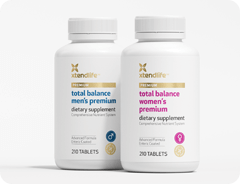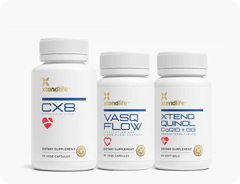This was the headline in an article by Stephen Daniells of Nutraingredients which we have reproduced below.
In a nutshell, researchers found that by combining high dose omega-3 fish oil with a cholesterol lowering statin drug that the reduction in triglycerides was quite dramatic.
But…that is no surprise as that is what high-dose fish oil does! I can’t quite figure out the logic for this study as it only reinforces what is already known which is statins have very little effect on triglycerides but omega-3 fish oils do.
I only mention this study because I know that we have many readers who are still on statin drugs through the pressure of their Doctors. The study at least confirms that it is not only safe to combine the omega-3 fish oil with the statins but beneficial.
Remember though if you are on a statin drug that your body’s supply of CoQ10 is being depleted which in turn will lead to serious problems. So, if you are taking a statin drug please ensure that you use our Premium QH CoQ10 version of our Omega-3 fish oil because it contains Ubiqui(nol) (CoQ10). This is the genuine Kaneka Ubiqui(nol) and must not be confused with the 'normal' CoQ10 in the market place which is called Ubiquinone.
The Ubquinol is the non-oxidised form of CoQ10 and significantly more effective than the ordinary form which is oxidised and the body has to convert to Ubiqui(nol) which is why only a very small percentage is bioavailable.
Here is the article:
"Omega-3 plus statins effective for enhanced blood lipid control: Study"
By Stephen Daniells, 06-Oct-2010
Combining statins with omega-3 fatty acids may be more effective at managing raised blood lipid levels than statins alone, suggests a new study from Korea.
Six weeks of dual therapy was found to reduce blood levels of triglycerides by 41.0 percent, compared to 13.9 percent in the group receiving only statins (simvastatin), according to new findings published in the European Journal of Clinical Nutrition.
Both groups received a daily poll containing 20mg of simvastatin, while half of the participants also received an addition 4 grams of omega-3 per day, providing 1.86 grams of eicosapentaenoic acid (EPA) and 1.4 grams of docosahexaenoic acid (DHA).
Sixty-two people with high triglyceride levels, ranging from 200 to 499 mg per 100 ml, and total cholesterol levels greater than 200 mg per 100 ml participated in the six week prospective, randomized, open-label study.
"The combination of omega-3 fatty acids plus simvastatin, which achieved a significantly greater reduction of triglycerides without adverse reactions, should be considered as an optimal treatment option for patients with mixed dyslipidemia, " report the researchers, led by Professor Hyo-Soo Kim from the Division of Cardiology in the Department of Internal Medicine at Seoul National University Hospital.
Heart health and beyond
The study appears to support the already extensive data linking omega-3 intakes and improved measures of cardiovascular health. The heart health benefits of consuming oily fish, and the omega-3 fatty acids they contain was first reported in the early 1970s by Dr Jorn Dyerberg and his co-workers in The Lancet and The American Journal of Clinical Nutrition. To date, the polyunsaturated fatty acids (PUFAs) have been linked to improvements in blood lipid levels, a reduced tendency of thrombosis, blood pressure and heart rate improvements, and improved vascular function.
Beyond heart health, omega-3 fatty acids, most notably EPA (eicosapentaenoic acid) and DHA (docosahexaenoic acid), have been linked to a wide-range of health benefits, including reduced risk of certain cancers, good development of a baby during pregnancy, joint health, and improved behaviour and mood.
Despite such benefits there are still problems with ensuring adequate omega-3 intakes from fatty fish. This has led to a fleet of omega-3-rich concentrates becoming available. Projections by Frost & Sullivan set annual growth for the omega-3 market at an impressive 24 per cent, and the market is estimated to be worth $1.6bn by 2014.
Study details
The participants were randomly assigned to received either the statin therapy alone or in combination with the omega-3 supplements (Omacor, Solvay Pharmaceuticals) for 6 weeks. Fifty people completed the trial with seven drop outs from the combination therapy group and five from the simvastatin-only group. Of those that did complete the study, compliance with the intervention was good, with over 90 percent of statin and omega-3 capsules consumed in the combination group, compared with 87 percent in the statin-only group. Results showed that the omega-3 plus statin group experienced average decreases in triglyceride levels from 309.2 to 177.7 mg per 100 ml, compared with a reduction from 294.6 to 238.3 mg per 100 ml in the simvastatin-only group.
Additionally, significant reductions were observed in LDL cholesterol levels in both groups, while HDL levels were not affected by either intervention, said the researchers.
Professor Kim and his co-workers note that the results echo those from Western populations (Maki et al . 2008, Am. J. Cardiol., Vol. 102, pp. 429-433 & Davidson et al., 2007, Clin. Ther., Vol. 29, pp. 1354-1367).
"In contrast to the potential serious side effects of combinations of statins with fibrate, a combination therapy of omega-3 fatty acids and simvastatin showed few adverse events, " wrote the researchers. "Thus, it could be considered as good therapeutic choice for patients with mixed dyslipidemia, lowering triglycerides by 40 percent without mitigating LDL cholesterol reduction by statins."
The study was funded by the Innovative Research Institute for Cell Therapy (IRICT) and the Clinical Research Center for Ischemic Heart Disease in South Korea.
Authors: European Journal of Clinical Nutrition
Published online ahead of print, doi:10.1038/ejcn.2010.195
"Prospective randomized comparison between omega-3 fatty acid supplements plus simvastatin versus simvastatin alone in Korean patients with mixed dyslipidemia: lipoprotein profiles and heart rate variability"
Authors: S-H. Kim, M-K. Kim, H-Y. Lee, H-J. Kang, Y-J. Kim, H-S. Kim


 Supplements
Supplements Bundles
Bundles









